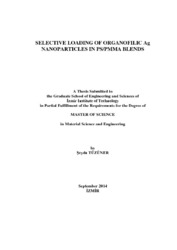Please use this identifier to cite or link to this item:
https://hdl.handle.net/11147/4186Full metadata record
| DC Field | Value | Language |
|---|---|---|
| dc.contributor.advisor | Demir, Mustafa Muammer | - |
| dc.contributor.advisor | Ebil, Özgenç | - |
| dc.contributor.author | Tüzüner, Şeyda | - |
| dc.date.accessioned | 2014-11-18T14:29:07Z | |
| dc.date.available | 2014-11-18T14:29:07Z | |
| dc.date.issued | 2014 | - |
| dc.identifier.uri | http://hdl.handle.net/11147/4186 | - |
| dc.description | Thesis (Master)--Izmir Institute of Technology, Materials Science and Engineering, Izmir, 2014 | en_US |
| dc.description | Includes bibliographical references (leaves: 37-39) | en_US |
| dc.description | Text in English; Abstract: Turkish and English | en_US |
| dc.description | ix, 39 leaves | en_US |
| dc.description.abstract | The association of nanoparticles with polymer blends offers significant features beyond the advantages of polymer composites prepared by single homopolymer. Since the blends undergo phase separation due to incompatibility of the constituent polymers into various internal structures, the particles can be segregated into one of the phases. Different location of the particles allows to develop novel microstructures; and thus, control over physical properties. In this study, Ag nanoparticles were prepared by reduction of AgNO3 via NaBH4. The particles were capped by cetyl ammonium bromide (CTAB) and were mixed with equimass blend of polystyrene (PS) and poly(methyl methacrylate) (PMMA) in tetrahydrofurane (THF). The solid content of blend solution was fixed at 2.5% w/v. The concentration of the particles with respect to polymer blend was at 0.7 wt %. The composite film was cast on glass slide. Surface feature of the composite films was examined by atomic force microscopy (AFM) and scanning electron microscopy (SEM). The surface of blend film without particles shows spherical pits with a size of 4.5 μm and rich in terms of PMMA. When particle size was small (diameter is around 20 nm), they preferentially located at the interface of the domains. The large particles with a diameter of 90 nm were found to locate in PMMA phase. Upon annealing of the composite film at 165 ˚C for 3 days, the particles move to the PS domains independent of the particle size and merely PS loaded composite is achieved. | en_US |
| dc.language.iso | en | en_US |
| dc.publisher | Izmir Institute of Technology | en_US |
| dc.rights | info:eu-repo/semantics/openAccess | en_US |
| dc.subject.lcsh | Polymers | en_US |
| dc.subject.lcsh | Polymeric composites | en_US |
| dc.subject.lcsh | Nanoparticles | en_US |
| dc.title | Selective Loading of Organofilic Ag Nanoparticles in Ps-Pmma Blends | en_US |
| dc.title.alternative | Organofilik Ag Nanotaneciklerin Ps/pmma Karışımları İçersindeki Seçimli Yüklenmesi | en_US |
| dc.type | Master Thesis | en_US |
| dc.institutionauthor | Tüzüner, Şeyda | - |
| dc.department | Thesis (Master)--İzmir Institute of Technology, Materials Science and Engineering | en_US |
| dc.relation.publicationcategory | Tez | en_US |
| dc.identifier.wosquality | N/A | - |
| dc.identifier.scopusquality | N/A | - |
| item.openairecristype | http://purl.org/coar/resource_type/c_18cf | - |
| item.languageiso639-1 | en | - |
| item.openairetype | Master Thesis | - |
| item.grantfulltext | open | - |
| item.fulltext | With Fulltext | - |
| item.cerifentitytype | Publications | - |
| Appears in Collections: | Master Degree / Yüksek Lisans Tezleri | |
Files in This Item:
| File | Description | Size | Format | |
|---|---|---|---|---|
| 10013243.pdf | MasterThesis | 1.7 MB | Adobe PDF |  View/Open |
CORE Recommender
Page view(s)
286
checked on Mar 31, 2025
Download(s)
104
checked on Mar 31, 2025
Google ScholarTM
Check
Items in GCRIS Repository are protected by copyright, with all rights reserved, unless otherwise indicated.